Drive to Mexico: Friday Morning 2/10/06
With both us and our camera recharged, we take on some new experiences. (Still working to upload our pictures; I'll try again later.)
Mmmm...Beanie Weenies
Yesterday the challenge was in getting everything done that had to be done. Today we have no time demands. The challenge now is that we have only one full day left here, but at least two weeks worth of possible things to do. Which to choose?
One thing we've already decided: We'll do all the driving today. No matter if it's in downtown rush traffic, or on potholed mountain roads. In the end we do a little of both.
We consider our options over a complimentary hotel breakfast of eggs, sausage, cereal, pastries, fruit yogurt, and refried beans. Lots of refried beans. Picking the sliced hot dogs out of our eggs (guess which part we eat), we pull out our guides and maps. Time for some heavy thinking work.
Option one is to ascend several thousand feet of steep, twisty road to the top of the Chipinque Mesa. It is south of town, and has a spectacular view across the whole Monterrey basin. Along the route back is the Alpha Planetarium and Science Museum, with IMAX. This is supposed to be the best of its kind in all of Mexico.
Option two is to go to downtown Monterrey and walk the Gran Plaza…the second-largest city park in Mexico, surrounded by at least a dozen top-notch museums and tourable historic buildings. One museum tells the story of Mexican history, and it features tours in English. Alongside it is what one of our guidebooks call an "artificial river" that commemorates the river that still ran through this valley when it was discovered back in the 1500’s. The real river disappeared long ago. The Guide shows pictures of happy families riding paddle boats up and down its waters.
Option three is to travel towards Saltillo, another major industrial city to the west of Monterrey. This would take us further into the mountains, and is reputed to be a prettier drive than anything we've yet seen. It would also take us closer to a typical part of Mexico that is more typical in the authentic, native crafts we've been hoping to find. We have a guidebook chapter full of bargaining phrases, and are eager to try a little serious bartering.
One of our travelogues says not to try option one when it is wet. The forecast shows a possibility of rain. Scratch number one.
Option two looks interesting, but neither of us is in the mood to stay in a city.
That leaves option three. I read to Debbie the section of the Sanborn book covering this area, and she suddenly leans forward when I reach the "Grutas de García:"
"GRUTAS de GARCÍA (GARCÍA CAVES) IS A TOP ATTRACTION, with spectacular formations of stalactities and stalagmites, 40 minutes from town towardWe have a plan.
Saltillo at Villa de García. Caves close at 4:00, so leave early! The drive
is beautiful. There is a playground for kids and swimming pool. They now
have a little tramway to take you to the illuminated caves."
"West to Saltillo, South of the USA"
Setting off from the hotel, we know we have to find again the autopista that loops around the top of town. Beyond the section we were on yesterday is the path to Saltillo. Today Debbie is driving and I am navigating.
We follow the signs to Saltillo and end up at a pay booth for a road headed north. Because we want to go west, and because the road signs have up till now been so consistently misleading, I become convinced that we have taken a wrong turn. We pull up to the only open booth. Using my translator, from the passenger seat I try to express that we are on the wrong road. The road has been completely empty until now, but now of course several cars immediately pull up behind us. Debbie tries to hand-signal that we just want to go forward and come back around through the return booth. The problem is, the road ahead is divided and there is no way to get back to the return lanes.
The lady motions to her supervisor, who is sitting in the next (closed) booth. He walks over and I manage to make our predicament clear. He steps back and waves the cars behind us to back up. Then he motions for us to back up, and points to a chained opening between us and the return lanes. Unclipping the chain, he gestures for us to move ahead. I say "Saltillo," and he stops. "No,"and points to beyond the booth, where we were just heading. "Saltillo?" I ask. "Sí." He clips the chain back, and has us turn around and get back in line for the toll booth. Despite all the confusion, soon we have paid our toll, and are on our way. (Not for the first time or the last, Debbie and I say to each other "we’ve got to learn some Spanish before we come back!")
As with yesterday’s autopista, there is almost no traffic. Soon we begin to see more of the devastated housing you expect in Mexico. Set well back from the autopista, the structures are mostly concrete…perhaps because there aren’t enough trees here to build with wood. For roofing these "houses" have strips of sheet metal perched crazily on the tops of bare block walls, leaving what often appear to be open holes to the sky. Other walls have no covering at all. We see nobody; perhaps because it is now mid-morning.
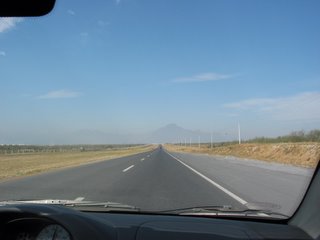 We can just make out the hazy outline of mountains to our west; close enough they should be crisp. Air pollution. You don't see it further to the east; perhaps prevailing winds push it towards where we were headed. Maybe it is because most of the heavy industry is in this area. No way to tell.
We can just make out the hazy outline of mountains to our west; close enough they should be crisp. Air pollution. You don't see it further to the east; perhaps prevailing winds push it towards where we were headed. Maybe it is because most of the heavy industry is in this area. No way to tell.Villa de PC Computer Cases
 Thankfully we have soon driven out of most of the pollution and begin to see the mountains more clearly. For once, a Mexican exit is well marked: "Villa de García." We take the turn, and it carries us to what will become one of my most interesting and vivid memories of Mexico; a village that has grown up around the concrete industry.
Thankfully we have soon driven out of most of the pollution and begin to see the mountains more clearly. For once, a Mexican exit is well marked: "Villa de García." We take the turn, and it carries us to what will become one of my most interesting and vivid memories of Mexico; a village that has grown up around the concrete industry.Passing the tall cylinders of a concrete plant and many large transporter trucks on the road, we soon approach what seems to be worker housing. Aside from a rather messy area of roadside work, it looks very neat and clean; prosperous by Mexican standards. Before the subdivision is a billboard with a man backed by his smiling wife and two children. He has just paid 175,000 pesos ($17,500 U.S. dollars). From the adoring expressions of spouse and offspring, it is clear he has made "the right decision."
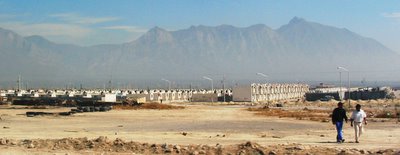 Organized like the containers in a well-run warehouse, the development holds row after row of masonry boxes. The two-story ones resemble personal-computer tower cases: Narrow, deep, and tall. The effect is antiseptic and unique, like nothing in either a typical American subdivision or a slum.
Organized like the containers in a well-run warehouse, the development holds row after row of masonry boxes. The two-story ones resemble personal-computer tower cases: Narrow, deep, and tall. The effect is antiseptic and unique, like nothing in either a typical American subdivision or a slum.We drive slowly through the village, and come upon our first tope of the trip. A tope is a series of rows of tall metal domes crossing the road. They work a car's suspension like the torture-test section of a Detroit test track. We come to a near stop as the front wheels rise, then drop, then up come the rear wheels and back down again. Good job, Deb! Undercarriage still intact; only a slight scrape in the middle.
Now we enter the zone of sensory overload: On one side of the road is one hut after another, fronted by tables and chairs that could well have been rescued from a nearby dumpster. In a way they resemble the cafes we know in the U.S., but with a healthy extra dollop of "official-looking pink slip on the door" chic. Nevertheless, we smell the most delicious odors of our whole stay in Mexico.
Finally we draw alongside two houses that look at least vaguely familiar to Americans; closer to 1950’s California Ranch than anything. I wonder aloud if one of them belongs to the mayor. It has several orange trees in the backyard, each sagging under a full load of plump bigger-than-regulation-softball sized fruit.
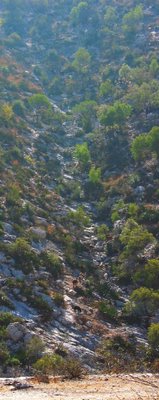 In five minutes we are through the town and moving on towards the caves, perhaps 5 miles away. Though the road is small, two laned, and heavily trafficked by large clean dump trucks, it is in fairly good shape. Steep cliffs rise just a short walk away on both sides. Far up the wall on the left side we see a circular hole of unnaturally-perfect roundness. Yet we can see no obvious way for people to get there, nor any sign in the slope below that they ever did. We can't imagine why or how it is there, or anything useful that one could do with it.
In five minutes we are through the town and moving on towards the caves, perhaps 5 miles away. Though the road is small, two laned, and heavily trafficked by large clean dump trucks, it is in fairly good shape. Steep cliffs rise just a short walk away on both sides. Far up the wall on the left side we see a circular hole of unnaturally-perfect roundness. Yet we can see no obvious way for people to get there, nor any sign in the slope below that they ever did. We can't imagine why or how it is there, or anything useful that one could do with it.Coming up on the right now is a graveled turnout at an especially pretty narrows. We stop to shoot pictures. Opening my door we hear the musical clattering of bells. To our right a dog is driving a group of goats straight up a steep rocky slope. Their bells are clapping as they scamper upwards. There's no shepherd in sight.
I work myself through a partial circle to snap a set of shots that my software at home will stitch into a 270-degree panorama of the surrounding cliffs. I have just one more shot to take when…the lens retracts into the body and the camera shuts itself off. Battery dead again, and there's still a whole day of adventuring ahead.
 (Click on this picture to see a larger version. Hold the cursor over that version and soon a symbol will appear in the lower-right corner. Click on that to see a HUGE version.)
(Click on this picture to see a larger version. Hold the cursor over that version and soon a symbol will appear in the lower-right corner. Click on that to see a HUGE version.)We drive on and soon reach the parking lot for the caves. At the entrance is a booth where you pay a couple of dollars worth of pesos to park. I reach out to hand the lady our money. She says the word "teleferica", which we know from the sign up the road means the tram up to the caves, and then something about an hour and fifteen minutes. It seems to me she is saying the tram is not operating today, and it will take us an hour and a quarter to walk to the caves. The nearly empty parking lot ahead of us confirms this interpretation. Debbie and I quickly confer and decide to press on. We've come too far to turn back now! I pay and we pull into a neatly-lined spot.
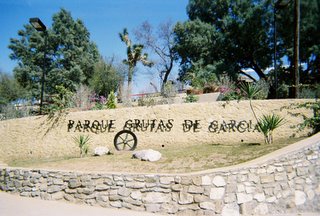 This is the most beautifully-manicured place we have yet seen in Mexico…neatly landscaped, with retaining walls that look professionally formed instead of seeming hand-molded with playdough, sculptured grass, trimmed plants, and a sign done in artistic black metal. We stop at the little souvenir shop at the beginning of the path to the main section of the park, and buy a disposable odak camera. Then we walk up the hill to where you buy attraction tickets.
This is the most beautifully-manicured place we have yet seen in Mexico…neatly landscaped, with retaining walls that look professionally formed instead of seeming hand-molded with playdough, sculptured grass, trimmed plants, and a sign done in artistic black metal. We stop at the little souvenir shop at the beginning of the path to the main section of the park, and buy a disposable odak camera. Then we walk up the hill to where you buy attraction tickets.Leveling out, we turn left and enter an area as nice as Six Flags, only on a much smaller scale. More than anything we've yet seen, everything is neat and clean and pretty. Even the restrooms are pristine. At the ticket booth I see the prices for going to the cave: 60 pesos each with tram ride, 45 without. Using Jon’s translator, I attempt to
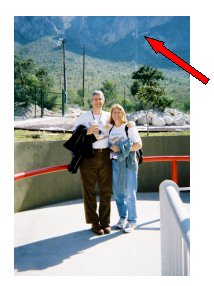 ask about the tram and the walk. This time we hear "thirty minutes." That's not too bad...and neither of us want to leave without seeing the caves. Our eyes follow the overhead tram cables to the distant landing dock where you enter the caves, far up a nearby mountain (the picture really doesn't capture the distance). Wow; thirty minutes seems pretty quick...but they're the experts; they should know!
ask about the tram and the walk. This time we hear "thirty minutes." That's not too bad...and neither of us want to leave without seeing the caves. Our eyes follow the overhead tram cables to the distant landing dock where you enter the caves, far up a nearby mountain (the picture really doesn't capture the distance). Wow; thirty minutes seems pretty quick...but they're the experts; they should know!I pay and we set out. As we get closer we begin to see that the path zig-zags its way up the face of the mountain. The first zig is brutally steep. We both stop to catch our breath (it’s been months since either of us have been well enough to do much physical). That's when we are suddenly startled by a little old lady blowing by us on her way back down the mountain, fresh as a morning flower. "Hola," she says. "Ho ho ho la" we pant.
As soon as she disappears--which is really all too soon for us--we start on another zig. Thus we go for awhile, climbing a couple and stopping, panting, dizzy, but determined. About fifteen minutes of this is all that Debbie’s stomach wants to hear about: Like a good protest marcher, it begins picketing. When that doesn't work, it escalates the warning to nausea. Deb still presses on. Now the stomach is really hacked off. Deb has had her opportunity to comply; now nothing will do short of corporeal punishment. First comes the watering mouth, then a quick walk off the trail to the bushes. Bye, bye breakfast. As I hold a comforting hand on her back, yet another little old lady burns by us, power-walking like she's on team Mexico, Beijing 2008. "Hola," she says brightly. "Hola," I smile back weakly. We'll have three more of them pass us by before this walk is done.
Debbie feels much better. I ask repeatedly if she wants to go back, but she has already paid the price and is not about to quit. What a trooper! Her stomach having played its ultimate hand and lost, now seems ready to play nice. On we go, endlessly tracing out the same pattern: zig, sit, pant, zag, sit, pant, repeat. What a beautiful day! 75 degrees or so, dry, light breeze, shaded by the mountain we're climbing. We feel both challenged and fulfilled.
Halfway up we hear and then see the tram undock from its moor above and head down the mountain. It runs close to our trail, so we can see that inside are a couple of park workers. They must be doing a little troubleshooting so they’ll be ready for the crowds another day.
Now we are a little further up, and the tram returns. Loaded with people. What in the world?! Visitors! We figure out that the ladies below were trying to tell us, not how long it would take to walk up the mountain, but how long the wait would be before the tram started running!
A little later, just as we reach the top, a second load of tourists arrives. Debbie and I are sweat-soaked and drooping. They all look crisp and wide-eyed. As they chatter away in Spanish, everyone collects into a single, large tour group.
Immediately the guide begins speaking at length of the glories of the cave, in Spanish of course. Soon an older gentleman from the group of tram cheaters—I mean, riders—turns to a younger couple alongside him, and says in impeccable English, "do you think they might want to know what the guide is saying?" To which the younger couple replies "oh yeah, they probably do." I had no idea we are so obviously gringo.
The younger couple, Jaime (pronounced "Hi May") and Michelle, seem to be roughly in their late thirties. She was born in Ohio, and they with their children have spent the last few years in Iowa. They just moved to Texas in May of 2005. Their group is on a weekend marriage retreat from Faith Church, near McAllen Texas. With their pastor and his wife they’ve spent the previous night at a hotel on the Chipinque Mesa...where we’d considered going this morning. Now they were at their next stop, the caves. Most everyone in their group speaks English.
What has started as a visit to a natural wonder has suddenly become a divine appointment. We enjoy the caves so much more with our new friends, with whom we talk more about the Lord and our families than we do about the admittedly spectacular crystalline formations surrounding us. The whole group is chattering away now, stringing out more and more over the path and falling progressively further and further behind the guide, who is still at the front. At one point he chastises us all for not keeping up; Jaime shoots back good-naturedly, "if he wants us to keep up, he’ll have to move everyone in front of us out of the way!"
At the "Christmas Tree" formation, a tall tree shape in the middle of a large half-domed room topped 300 feet up by two openings to the clear blue sky, I take a group shot of the McAllen folks. This way their pastor can be in the frame. And they shoot a picture of Debbie and me as well, which unfortunately comes out almost completely black. Oh well!
The last two venues in the caves are "glory" and "inferno," as in heaven and hell. Glory is a little grotto with a shrine to the Virgin Mary. I'd always pictured heaven a little grander, but it is pretty in a kitschy sort of way. Hell is a narrow slot heading down into unseen depths, first horizontally and then tailing over. It is all backlit with an underworldly glow by an unseen red lamp. We all laughingly agree that none of us would want to go there.
As we exit the cave, I ask Jaime if he would mind putting in a word for us with the tram operators. Would he explain to them that we thought the tram wasn’t operating today, and are willing to pay the difference so we can ride down instead of walk? He speaks with them a moment in Spanish, and they quickly agree we can ride…at no extra charge. Hallelujah! We are about to officially join the tram-cheaters club!
As we wait for the tram to load, we look down the side of the mountain below the overhead lines. There are parallel railroad tracks, leading down to the main recreational and ticket area at the bottom. Apparently the way to get up and down was once a little train. I remark that this would have been a fitting conclusion after viewing hell, knowing that you were about to get into a train headed straight downhill! Looking at the near-vertical angle, I still can’t believe that anyone would have ever ridden it.
Riding down on the tram we look over onto the path we’d climbed a short while earlier. From this angle it is so long and steep that we can't believe we’d made it. Then somebody notices the placard on the tram is for a Swiss company, and wisecracks about how it took the Swiss to get us all safely up and down a Mexican mountain.
We trade addresses and contact info with Jaime and Michelle, inviting them to come to our place in Fort Worth. They return the invitation, asking us to come see them in south Texas. Everyone sits around for awhile in the park and visits. As we talk, a Mexican lady who is not with their group speaks a little English, and asks Jaime "Christian?" I could somehow tell she isn't asking about denomination or cultural Christianity, but being an authentic follower of Jesus...though don’t ask me how I can tell. He says "Sí," and they say a few more words to each other in Spanish. She seems somehow comforted by his reply.
It is time to go, so we wave goodbye to them all and say we might come see them sometime, perhaps even at their church. They all smile, wave, and bid us well. Down the walkway and to the car we retrace our steps; opening doors, stepping inside, backing out, and pulling away…feeling very blessed through the Lord's little flock from McAllen.

1 Comments:
Waiting for the rest of the story!!!! ?????
:)
Love you.
Post a Comment
<< Home